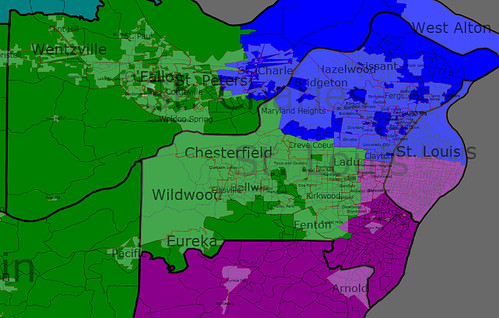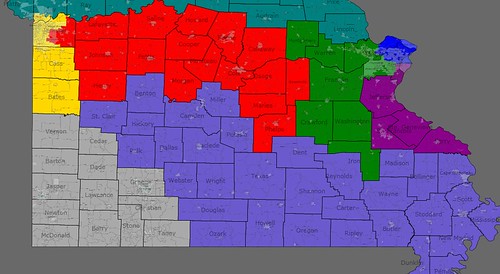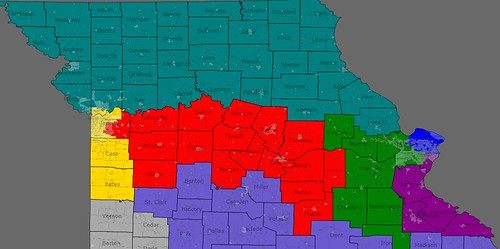Okay, so as my first diary, I’m sure this is overly long, but I wanted to add a lot of data and analysis as I could because I am relentlessly geeky.
So read on, if you dare…
Shout-out: Dave’s Redistricting App.
Missouri Congressional districts Post-2010 Census
With Missouri most likely dropping a seat and with the redistricting authority evenly split between the Democratic Governor and Republican Legislature, incumbency protection and relatively even numbers of safe and swing districts should be considered priorities. Plus, with the political battles likely to be intense enough to be settled by an independent-ish panel, I figured that drawing geographically-sensical boundaries would also be important.
Therefore, I tried to keep each county in the same district (which I did successfully, barring the expected biggies–Kansas City’s Jackson and St. Louis city and county). This was done as a proxy for the “communities of interest” standard that seems to crop up when redistricting time rolls around, but I ain’t a lawyer and don’t know about no redistrictin’.
An added bonus of this map is that each area is contiguous and geographically-sensible. Finally, in terms of population, each of the 8 districts clocks in around 739,000 using the awesome Dave App’s “Use New Pop Est” feature. The biggest variance is less than 5,000 + or – and I figure some changes from the estimate are to be expected, so some tussling around the edges should be expected. The counties of Gasconade, Crawford, Phelps, Dent, Iron, St. Francois, Montgomery and St. Clair could all be shifted between at least 3 Congressional districts to equalize populations and still be a part of pretty sensible, contiguous districts. So what I’m trying for is a good working template for starting negotiations.
Relevant recent races:
Governor – 2008 — Democrat Jay Nixon vs. Republican Kenny Hulshof 58.4-39.5
Longtime Attorney General Jay Nixon stomped the lackluster Hulshof (after Sarah Steelman weakened him severely in the primary). I use this as a sort of shorthand for what a reasonably strong Democrat could potentially do. (although some Congressmen like Ike Skelton defy the odds even further once they’re entrenched incumbents). Basically, a solid, local but new-to-a-seat Democrat could outpoll Nixon by a few points, perhaps, but not much more.
President – 2008 — Democrat Barack Obama vs. Republican John McCain 50-50
Missouri’s bellweather status ended when McCain took a 4,000 vote victory over Obama out of almost 3 million ballots cast (ftr, national average was 53-47-ish). It’s an interesting shorthand for outsiders, but its variance from the Nixon numbers is an important insight into the actual voters of a county.
With that, here we go….
St. Louis Close-Up

———–
Blue-District 1: Rep. Clay, D
Residence: St. Louis
Old Cook PVI: D+27
Gains: much of the city of St. Charles, plus that county’s eastern reaches
Loses: fairly small parts of St. Louis county & St. Louis proper
Keeps: Half of St. Louis proper, northeast chunk of St. Louis county
Analysis: As drawn, the massively-Dem PVI will shrink, but only modestly, probably to around D+16 or so. I would expect neighborhood tweaks because STL is the most densely-populated part of the state. Instead of black-majority, this district will be almost evenly matched, about 51% white to 42% black according to the app, but I’m going out on a limb and saying that shifts in population (ie-the inner suburbs getting more racially-mixed) will make this really, really close by the time the Census is held.
Effectively, St. Charles may tip the racial balance, but likely not the political one. Clay, one of MO’s two African-American Congressmen, should definitely be safe in this district, whatever its racial makeup. If the Voting Rights Act requires a black district, it should be easy enough to shift a few precincts on the margins (ie-losing parts of St. Charles, adding parts of STL) to bump it up to 50% black.
———————-
Green-District 2: Todd Akin, R
Old PVI: R+9
Residence: Town & Country
Gains: Montgomery County (pop. 12,000), Warren Co. (30,000), Franklin (100,000), Crawford (23,000), Washington (23,000), Iron (10,000), southwestern St. Charles county
Loses: Lincoln county (pop. 51,500), eastern St. Charles county
Keeps: Most of St. Charles county (though not St. Charles itself) and southwest St. Louis county
Franklin: Obama-McCain 43-55, Nixon-Hulshof 51-47
Warren: Obama-McCain 43-56, Nixon-Hulshof 49-49
Washington: Obama-McCain tie (5-vote margin), Nixon vs. Hulshof 67-31
Crawford: Obama-McCain 40-60, Nixon-Hulshof 52-46
Iron: Nixon-Hulshof 64-33, Obama-McCain 50-47
Analysis: Akin keeps most of his base in the western and southern sections of St. Louis county, but he loses part of St. Charles and picks up a set of rural-ish counties in return. Those rural-ish counties aren’t quite as Republican-friendly as he’d like–Obama won Washington & Iron, and stayed competitive in the rest, while Dem Gov. Nixon did very well in all of them.
The rural counties provide about 200,000 residents, while suburbanites (read: most of Akin’s base) make up the rest of this district. Akin is weakened, but only slightly. This should count as a “safe Republican” seat, especially because most of the St. Charles areas I removed are the swingiest parts of the county.
————
Purple-District 3: Russ Carnahan, D
Residence: St. Louis
Old PVI: D+7
Gains: A few more bits of St. Louis, plus St. Francois & Perry counties
–St. Francois county, pop. 63,000
Nixon-Hulshof 64-35
McCain-Obama won 51.5-47
–Perry county, pop. 18,800
Hulshof-Nixon 52-46
McCain-Obama 64-35
Loses: Not too much–a few St. Louis county and city neighborhoods where borders were tweaked.
Keeps: The aforementioned, Ste. Genevieve, Jefferson, southeastern bits of St. Louis county, roughly half of St. Louis proper
Analysis: The bits of urban St. Louis added to this district keep it from leaning too far right, and St. Francois is actually fairly moderate–Jay Nixon outperformed his statewide average here. Conservative Perry County is too small to have much effect. Carnahan should be able to hold this district.
————-

Red-District 4: Ike Skelton, D
Residence: Lexington (Lafayette County)
Old PVI: R+14 (Obama 38-McCain 61)
Gains: Howard, Cooper, Boone, Callaway, Osage, Maries, Phelps, Gasconade, plus the south & eastern suburbs of Jackson County (Lee’s Summit, Blue Springs, Grain Valley, Lone Jack)
Loses: Barton, Vernon, Dade, Cedar, part of Polk, Dallas, Webster, Laclede, Pulaski, Camden, Ray
Keeps: Lafayette, Johnson, Henry, Pettis, Saline, Morgan, Moniteau, Cole
Analysis: This district sees some big changes to make it the probably the most swing-tastic of the new map. While Skelton can easily hold the old MO-4, it’s unlikely another Democrat could. The new MO-4 changes that to an extent, refocusing the district on the mid-section of Missouri, linking the Kansas City suburbs to Columbia and Jefferson City. In terms of community interests, it could be the “River District”, as it roughly follows the outline of the Missouri River through the middle of Missouri. But notice what else it is–an education/govt/services district. Behold….
Boone County (155,000): O-Mc 55-43, Nix-Hul 55-43 –>Columbia (MU, 30,000 students)
Cole (70,000): O-Mc 36-63, Nix-Hul 49-50 —> Jeff City (state capitol)
Johnson (50,000): O-Mc 43-55, Nix-Hul 54-43 —> Warrensburg (UCM, formerly CMSU, 10,000 students)
Phelps (43,000): O-Mc 38-60, Nix-Hul 53-44 —> Rolla (6500 students)
Pettis (40,000): O-Mc 38-60.5, Nix-Hul 55-43 —> Sedalia, state fair/services
Callaway (40,000): O-Mc 40-59, Nix-Hul 49-50 —> Fulton? Jeff City suburbs
Saline (24,000): O-Mc 48-50, Nix-Hul 57-33 —> Marshall, Missouri Valley College, 1500-ish students
Morgan (21,000): Nix-Hul 50-48
Cooper (17,000): Nix-Hul 46-52
Gasconade (15,000)
Moniteau (15,000)
Howard (10,000)
Maries (9,000)
——-
Yellow-District 5: Emanuel Cleaver
Residence: Kansas City
Old PVI: D+10
Gains: most of Cass county, all of Bates
Loses: Modest bits of southeastern suburbs of KC, like Lee’s Summit
Keeps: Most of Jackson County (Kansas City)
Analysis: Lost suburban bits compensated by swaps from northern suburbs, and the overwhelming urban tilt cancels the Cass/Bates suburban/rural tinge–no huge changes here and geographically it’s pretty similar, with mostly changes at the margins. Remains an urban district, perhaps now a smidge more conservative for a left-ish Dem like Cleaver, the former mayor of Kansas City, but still a pretty safe Dem seat.
Population centers: urban Kansas City, which went for Obama 78-21, is the majority of this district.
Cass County: Mc-O 60-40, Nix-Hul 52-46
Bates County: Mc-O 58-40, Nix-Hul 55-42
————

District 6: Sam Graves
Residence: Tarkio
Old PVI: R+7 (Bush-Kerry 57-43)
Gains: Practically every county in northern Missouri
Loses: Some Kansas City suburbs- wealthy Blue Springs and the closer-in Clay county districts
New PVI: Much more heavily Republican, probably R+15-20
Analysis: It’s the northern Missouri exurban-rural district, stretching from the northern Kansas City suburbs all the way to the outskirts of St. Louis. It becomes a blood-red district … Sam Graves is safe here as long as he wants. It’s perhaps not quite as ironclad as numbers might suggest–Nixon won a number of these counties, especially the ones that have higher populations (Buchanan, Platte, Clay). But the northeast is especially Republican and Sam Graves or a competent Republican should have no trouble holding this heavily-stacked district.
Main population centers: St. Joseph, Kansas City suburbs (Platte/Clay), rural northern Missouri
————
District 7: Roy Blunt (until the next election)
Old PVI: R+17
Gains: Barton, Vernon, Cedar, Dade, half of Taney
Loses: Polk
New PVI: Probably about the same, still heavily Republican
Analysis: It may not technically have the highest number of Republicans in terms of percentage of registered voters, but southwest Missouri is full of religious conservatives and this district will be safely, probably wingnuttily-Republican. But then again, it pretty much was before, so no major changes here. The borders expand modestly, but the flavor remains the same.
Main population centers are Joplin, Springfield and Branson (whose county, Taney, is now entirely in the 7th).
——–
District 8: Jo Ann Emerson, R
Residence:
Old PVI: R+15
Gains: Webster, Dallas, Polk, Hickory, Laclede, Benton, Camden, Miller, Pulaski, St. Clair
Loses: (other) Half of Taney, Washington, Iron, St. Francois, Perry, Phelps
Analysis: Jo Ann should like her new district–she loses the most Democrat-friendly parts (Washington, Iron, St. Francois) and picks up a slew of more conservative counties in south-central Missouri, stretching her district into the Ozarks. Although Emerson has been drifting gently toward the center (which basically means support stem cell research and uh…) since being elected in 1998, she’s still definitely conservative enough to represent this new district–after all, a lot of her new counties would be used to voting for Democrat Ike Skelton, so a center-right, but not far-right representative should do the trick.
“Main population centers” are…Cape Girardeau? Poplar Bluff?
Southern MO map:
http://www.flickr.com/photos/4…
———
District 9: Blaine Lueketmeyer
Residence: St. Elizabeth, Miller County
Old PVI: R+9
Disappeared!
His district is eaten by several others, and he now lives in Jo Ann Emerson’s new 8th. He has little chance to defeat her in primary as her base makes up the vast majority of this district.
But his previous district is now split between the new ones of Skelton, Akin and Carnahan, wi
So why would Republicans sacrifice ole Blaine?
Blaine will lose because he has the least seniority, other than whoever Blunt’s replacement is. But Blunt’s district makes sense–southwest Missouri–as opposed to Blaine’s crazy-shaped current 9th (“Little Dixie” …yeah, good try).
Why else dump Blaine? Because Republicans get a lot in return. Three totally safe districts, one mostly safe one, and they have a chance on at least one, if not two, of the “Democratic” districts. Democrats will like it because it’s a better balance and they may have a chance with Akin in the future. And with Skelton unlikely to make it another decade in Congress (though I hope and pray to God he does) they’re gonna lose one forever if they don’t agree to act now. Basically, you can gerrymander Missouri a lot worse.
Overall, despite its 2008 performance, Missouri is still the ultimate swing state, and having a 4-4 delegation (with one seat that could go to Republicans) seems right.
———
Other Missouri redistricting maps:
http://www.swingstateproject.c…
http://www.swingstateproject.c…
Source:
MO Gov Race – http://www.sos.mo.gov/enrMaps/… (MO Sec. of State’s office)
First, I think you did a great job with the analysis. If you want to post the maps to a diary, put in the HTML (not just the link.) That should do it.
I don’t think the GOP legislature will go for this. They will pass a map combining the most D parts of 1 and 3. Nixon will veto this map and then the courts will end up drawing the map. What will the courts do?
MO-01 probably has to stay at least plurality Black though. But you’re right; with the decline of inner-city St. Louis and the continuing integration of the suburbs, it’s within the realm of possibility that your MO-01 will be plurality Black by the census. At least it might be close enough that it just takes a few minor adjustments.